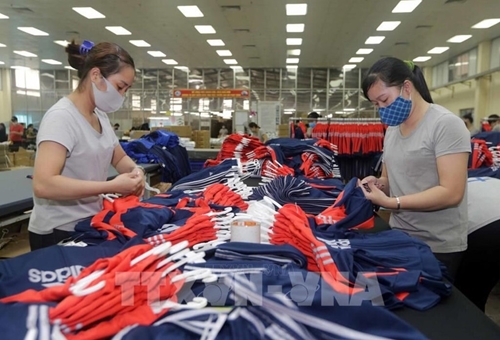He highlighted several key drivers of growth, beginning with sound economic management that strengthened resilience against the COVID-19 pandemic and global geopolitical uncertainty. The Government acted decisively with flexible measures and timely fiscal and monetary policies to mitigate supply chain disruptions and heightened international instability, he noted.
    |
 |
|
In the first seven months of 2025, Vietnam's exports reach 262.44 billion USD, up 14.8% year-on-year. |
Robust trade has gone hand in hand with strong industrial production. Vietnam has become increasingly integrated into global and regional production networks. In the first seven months of 2025, exports reached 262.44 billion USD, up 14.8% year-on-year, while imports rose 17.9% to 252.26 billion USD, generating a trade surplus of 10.18 billion USD. The industrial index of production also grew 8.6%.
Investment, both foreign and public, remains another crucial pillar. Record foreign direct investment (FDI) inflows have played a central role in boosting growth. Between January and July, realized FDI rose 8.4% year-on-year to 13.6 billion USD, while registered pledges hit 24.1 billion USD, up 27.3% from a year earlier. Effective public investment disbursement has also sustained growth, with Vietnam’s public debt - at around 36–37% of GDP - leaving ample fiscal space for major infrastructure projects.
Domestic consumption has remained relatively stable despite recent global headwinds, thanks to fiscal stimulus measures such as a 2% cut in value-added tax (VAT) and other tax incentives and spending programs.
At the same time, the Government has pushed forward comprehensive institutional reforms, considered vital for long-term growth, and continues to pursue an open policy toward trade and investment while actively managing external risks. Vietnam’s early efforts to negotiate reciprocal tariffs with the US demonstrate this proactive approach.
These drivers collectively contribute to Vietnam's impressive growth and its ability to navigate global challenges, Chakraborty said.
Outlook and challenges
The ADB Country Director cautioned, however, that Vietnam faces mounting headwinds in the short to medium term. Escalating tariffs, retaliatory measures, the protracted Russia – Ukraine conflict, and instability in the Middle East are expected to weigh on growth prospects.
According to the July 2025 Asian Development Outlook, Vietnam’s GDP is forecast to expand by 6.3% in 2025 and 6.0% in 2026, slightly down from April projections of 6.6% and 6.5%. In the first half of 2025, investment, exports, and domestic consumption remained the key growth drivers, but external factors like FDI and exports are unlikely to sustain their strong performance. This gives Vietnam an opportunity to strengthen domestic drivers, particularly public investment.
Amid rising uncertainties, Chakraborty stressed the need for proactive and long-term policy responses. As a highly open economy, Vietnam is vulnerable to shifts in global trade and investment flows caused by geopolitical tensions and protectionism. Enhancing competitiveness through higher-quality infrastructure, especially in transport and energy, will be essential to reduce logistics costs and improve economic efficiency in a green and sustainable way.
Comprehensive institutional reform, capital market development, high-quality human resources, and the expansion of high-value services and innovation are also needed to build a dynamic business ecosystem. In addition, a better business environment should encourage domestic firms to upgrade technology and management capacity, enabling greater value addition in global supply chains and stronger linkages with foreign-invested enterprises.
Chakraborty further emphasized that climate change poses a serious challenge for Vietnam, threatening infrastructure, livelihoods, and growth. Adapting to climate impacts and seizing opportunities for green growth must remain a strategic priority.
ADB’s cooperation priorities
Looking ahead, and in line with ongoing institutional reforms, Chakraborty said ADB will focus on several key areas of cooperation with Vietnam.
First is public investment and policy advisory in critical sectors. ADB can support government spending for projects and reform programs, particularly in infrastructure development and large-scale projects. Effective public spending remains a priority, and the bank will continue to provide technical assistance to support reforms, while also being ready to extend budgetary support to advance Vietnam’s development agenda.
Second is private sector development. ADB will continue supporting reforms that promote private sector growth, while providing financing - directly or through domestic financial institutions - for impactful private sector projects. Special attention will be given to small- and medium-sized enterprises (SMEs) and disadvantaged groups such as women-owned businesses.
Source: VNA